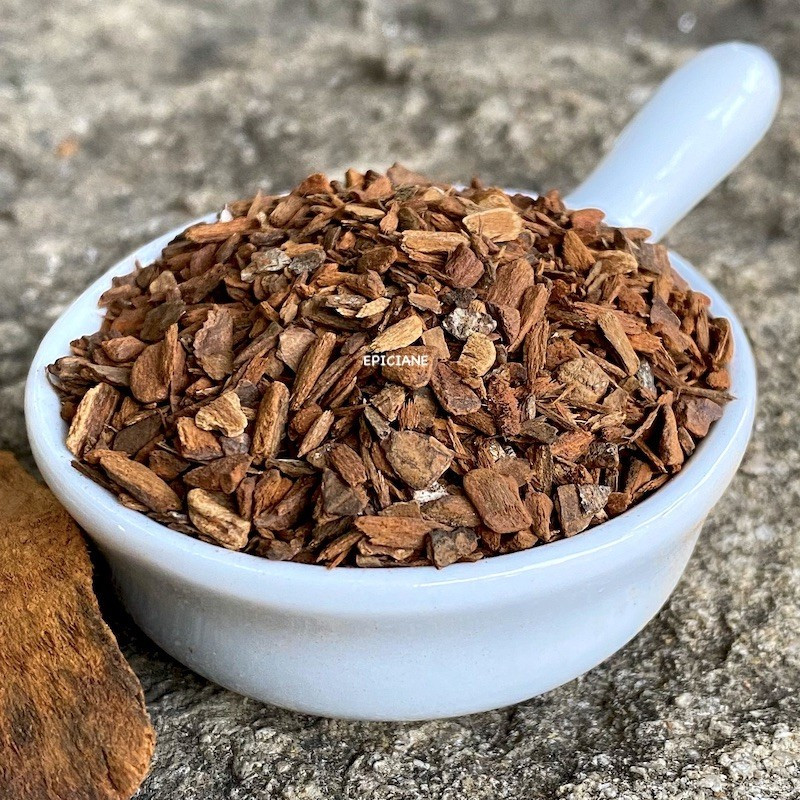
Reference: ecorceorangeamere


This bark, full of beneficial properties, is used in aperitifs both for its delightful bitterness and its medicinal virtues.
Tonic and bitter, cinchona stimulates appetite, reduces fever, and when used in lotions, strengthens your hair.
 Delivery
Delivery
Mondial Relay
 Returns
Returns
See conditions
 Payments
Payments
100% secure
Livré en sachet refermable
°°°
Appearance:
Cinchona is available in three forms: whole bark, cut bark, or powder.
Cinchona Wine Recipe:
Ingredients:
1 liter of red or rosé wine from Provence, 100g of sugar (preferably brown), 10g of gentian, 10g of cinchona, 10g of bitter orange peel, 10g of lemon peel, 1 vanilla bean split in two, 1/4 of a nutmeg cut into small pieces.
Let macerate for 15 days, then strain. Add 20cl of brandy (or 60° alcohol), mix, and bottle. This preparation can be stored for many months.
Uses in Cooking and Beyond:
Cinchona is known for its tonic and deliciously bitter properties, stimulating appetite and reducing fevers. It is considered one of the best remedies for flu-like symptoms due to its febrifuge and tonic effects.
Cinchona is often associated with aperitifs, and some old advertisements for these wines can still be seen on the walls of old houses. Tonic sodas, such as Schweppes or Canada Dry, also contain cinchona.
For making aperitifs, simply macerate cinchona bark in wine with added alcohol (to increase preservation by raising the alcohol content). Other ingredients like bitter orange and lemon peels, cinnamon, Roman chamomile, vanilla, Tonka beans, cardamom, gentian, and cacao can be added to enhance the flavor.
Its tonic properties also make it a good component for lotions and shampoos, particularly for revitalizing, oily, or dull hair, and even to help limit hair loss.
You can easily prepare a decoction with the bark (no more than 10% bark, so about 100g of bark for 1 liter of water):
This decoction can be used as a hair lotion or added to your shampoo (a higher concentration of cinchona in the decoction is acceptable if it will be diluted in shampoo). For this last use, you can also directly add cinchona powder to your shampoo in advance, allowing it to macerate and impart its tonic properties.
Who am I?
Origin: Ecuador
Scientific name: Cinchona pubescens
Also known as: Cinchona succirubra, oreja de mula, quina lanuda, hoja ahumada, hoja de zambo, quinoa rosa
There are three main types of cinchona: red, yellow, and gray.
Red cinchona is a tree from the Rubiaceae family that grows up to 10 meters high in its native regions of the Andes and Central America. It thrives in mountainous areas between 600 and 3300 meters above sea level. The bark, harvested in November and then dried, becomes a reddish-brown color and is particularly rich in quinine. Its pink flowers produce capsule-shaped fruit.
Cinchona cultivation spread throughout South America and was introduced to Africa and Asia. It has even become one of the most invasive trees in the Galapagos, causing problems in Hawaii and French Polynesia.
The bark is used to extract quinine, which it is rich in, as well as chloroquine, a compound that gained attention during the COVID-19 pandemic.
Its febrifuge properties make it one of the best flu remedies, and it is also a powerful tonic. Its analgesic effects relieve cramps and aches, although it can cause cardiac side effects and is contraindicated for pregnant women.
A Little History:
Until the late 18th century, the cinchona bark found in Europe came from Peru, and later from Bolivia. Wild cinchona was used until the mid-19th century, but to meet the growing demand for quinine, and due to the alarming scarcity of the tree in its native regions, Europeans sought to cultivate it in their colonies successfully.
It is now widely believed that the discovery of quinine in cinchona bark enabled European colonial expansion, especially in Africa, by helping combat fevers such as malaria. However, indigenous Americans had long known about the bark's febrifuge properties, reducing it to powder. Jesuit missionaries quickly capitalized on this knowledge, selling it under the name "Jesuit's powder."
Data sheet
 Brigitte M.
Brigitte M.
Parfait

 Brigitte M.
Brigitte M.
Parfait

Reference: ecorceorangeamere
Reference: gentiane
Reference: ecorcecitronH
Reference: ecorceorangeamere
Reference: ecorceorangeamere
Reference: badianeE
Reference: EPI2301010
Reference: punch
Reference: 2071570
Reference: baieroseE
Reference: gentiane
Reference: hypocras
Reference: 3N7137901
Reference: 10N7738802
Reference: vermouth
Reference: 2M6273801
Reference: 20731803
Reference: vinchaud

This bark, full of beneficial properties, is used in aperitifs both for its delightful bitterness and its medicinal virtues.
Tonic and bitter, cinchona stimulates appetite, reduces fever, and when used in lotions, strengthens your hair.